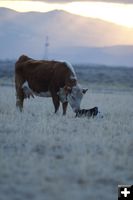

Hereford Pair
Healthy live calves are what every cow producer seeks for his annual yield.
|
|
Brucellosis vaccine implicated in abortion storm
by Cat Urbigkit
May 7, 2007
Although animal health officials have made a lot of progress on getting cattle producers in western Wyoming to adopt voluntary herd plans to reduce the risk of brucellosis transmission, that progress could come to a screeching halt, depending on how producers react to recent events.
USDA Animal and Plant Health Inspection Service personnel recently told the Wyoming Brucellosis Coordination Team that the agency has made quite a bit of progress in developing herd plans for individual cattle herds, but the herd plans are entirely voluntary. One herd plan has even been completed in Teton County, an action APHIS’s Dr. Bret Combs called a “milestone.” Teton County has been problematic with livestock producers feeling less than cooperative after the Taylor Ranch was put under quarantine by the Wyoming State Veterinarian after commingling with elk on a cattle feedline.
“We’ve had a bit of a rocky road throughout the process,” Combs said. Dr. Owen Henderson of APHIS reported that 80-100 herd plans have been completed, with many of these being standard plans involving herds with relatively low risk of disease transmission. He said that the herd plans are mainly a list of best management practices that many producers are already involved in.
But a Sublette County Hereford ranch experienced an abortion storm this spring in which it lost 5-6 percent of its calves, and the use of the RB51 brucellosis vaccine has been implicated in the problem.
Ranch owner Albert Sommers told the Wyoming Brucellosis Coordination Team that adult booster vaccination with RB51 was a part of his herd plan, so all his adult cows were vaccinated with a full dose of RB51 in November.
When the first abortion occurred, he called Henderson to investigate, also in compliance with his plan. The fetus was sent to the state veterinary lab, where a series of tests were conducted. Several fetuses were sent to the state lab, while others were sent to USDA’s National Animal Disease Center in Ames, Iowa. A battery of tests was conducted on the fetuses, and it appears Sommers will be stuck with the bill for the majority of the work.
“I think the bill ought to be picked up for somebody other than me,” Sommers told the team, but it was noted that under existing mechanisms for state funding, this type of testing isn’t covered. Dr. Bret Combs of APHIS said the only way his agency will pay is if the samples are picked up and submitted by his agency personnel (not producers or private vets) and then only the brucellosis testing would be paid for, not the testing for other possible disease agents.
Combs said his agency would probably request the signing of a written disclaimer from producers agreeing to the adult RB51 boost. That disclaimer would indicate an informed consent to the knowledge that if vaccination occurs in first trimester, the producer could experience 1-5 percent loss.
Sommers said: “I think people will really think hard before sticking a needle in a pregnant cow. I would never do it again.”
Sommers said he would consider giving cows a half-dose vaccination boost instead of a full dose, or would vaccinate open cows, but never again with pregnant cows.
It was noted that the experience on the Sommers ranch would probably be subject to a write-up in a veterinary journal. There is little published information about the abortion risk associated with RB51.
A research paper published in the May 1997 issue of the American Journal of Veterinary Research by scientists associated with the USDA’s National Animal Disease Center in Ames, Iowa, concluded: “Pregnant cattle can be safely vaccinated with strain RB51 without subsequent abortion or placentitis.”
Two years later, some of the same researchers published a paper about the responses of cattle to two doses of RB51 and found that the SRB51 “may persist in some cattle into adulthood but the incidence and significance of this persistence remains unknown.”
A paper published in 2000 by researchers with Argentina’s National Institute of Agriculture Technology examined the effect of the RB51 vaccine on pregnant cattle when given during the eight month of pregnancy. Although the vaccine did not induce abortion, the vaccine was recovered from milk for 69 days after vaccination.
In contrast, Wyoming Game and Fish Department researchers have demonstrated that the RB51 vaccine induces abortion when administered to pregnant captive elk.
Kansas State University clinicians reported in 1999 that Brucellosis developed in a 14.5-month-old Gelbvieh heifer after the animal was vaccinated with the calfhood dose of strain RB51 during the fourth month of its first pregnancy. Brucella abortus strain RB51 was isolated from the heifer’s placenta and her fetus' lung.
|
